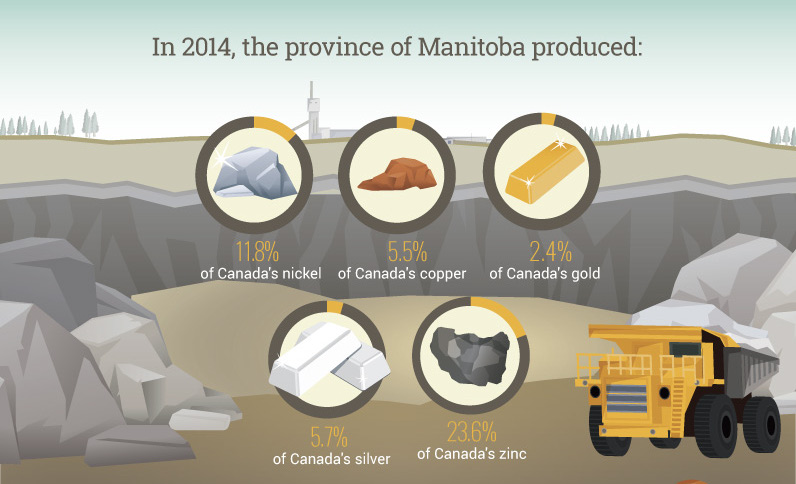Mining
Mining is a Crucial Industry for Manitoba

Mining is a Crucial Industry for Manitoba
Presented by: Mining Association of Manitoba
Mining in Manitoba had humble beginnings. Settlers of the province needed non-metallic raw materials, and began to extract salt from brine springs and stone locally for building materials.
However, the mining industry has changed dramatically since those days. Communities such as Thompson, Flin Flon, Snow Lake, Lynn Lake, Leaf Rapids, Bissett, and Lac du Bonnet were built on great mining deposits.
Today the mining industry is one of the most important sources of wealth in the province, consisting of 6% of the Gross Provincial Product. $1.3 billion of minerals were produced in 2013, and the workforce is approximately 3,200 people.
In terms of size, mining is the fourth largest primary industry in the province behind agriculture, hydro, and oil production.
Mining provides some of the safest and highest paying jobs in Manitoba. In terms of safety (lost time accidents) mining has dramatically improved over the years. In fact, mining boasted fewer cases of time loss injuries compared to other industry sectors such as agriculture, transportation, construction, manufacturing, and trade.
Salaries are also very high in mining compared to other industrial sectors. For example, the average salary in mining in Manitoba is $90,000, while other sectors took home between $55,000 and $60,000 on average.
In 2014, Manitoba produced 11.8% of Canada’s nickel, 5.5% of Canada’s copper, 2.4% of Canada’s gold, 5.7% of Canada’s silver, and 23.6% of Canada’s zinc.
Yet, only 1.4% of the country’s mineral exploration expenditures are in the province.
Lithium
Ranked: The Top 10 EV Battery Manufacturers in 2023
Asia dominates this ranking of the world’s largest EV battery manufacturers in 2023.

The Top 10 EV Battery Manufacturers in 2023
This was originally posted on our Voronoi app. Download the app for free on iOS or Android and discover incredible data-driven charts from a variety of trusted sources.
Despite efforts from the U.S. and EU to secure local domestic supply, all major EV battery manufacturers remain based in Asia.
In this graphic we rank the top 10 EV battery manufacturers by total battery deployment (measured in megawatt-hours) in 2023. The data is from EV Volumes.
Chinese Dominance
Contemporary Amperex Technology Co. Limited (CATL) has swiftly risen in less than a decade to claim the title of the largest global battery group.
The Chinese company now has a 34% share of the market and supplies batteries to a range of made-in-China vehicles, including the Tesla Model Y, SAIC’s MG4/Mulan, and various Li Auto models.
| Company | Country | 2023 Production (megawatt-hour) | Share of Total Production |
|---|---|---|---|
| CATL | 🇨🇳 China | 242,700 | 34% |
| BYD | 🇨🇳 China | 115,917 | 16% |
| LG Energy Solution | 🇰🇷 Korea | 108,487 | 15% |
| Panasonic | 🇯🇵 Japan | 56,560 | 8% |
| SK On | 🇰🇷 Korea | 40,711 | 6% |
| Samsung SDI | 🇰🇷 Korea | 35,703 | 5% |
| CALB | 🇨🇳 China | 23,493 | 3% |
| Farasis Energy | 🇨🇳 China | 16,527 | 2% |
| Envision AESC | 🇨🇳 China | 8,342 | 1% |
| Sunwoda | 🇨🇳 China | 6,979 | 1% |
| Other | - | 56,040 | 8% |
In 2023, BYD surpassed LG Energy Solution to claim second place. This was driven by demand from its own models and growth in third-party deals, including providing batteries for the made-in-Germany Tesla Model Y, Toyota bZ3, Changan UNI-V, Venucia V-Online, as well as several Haval and FAW models.
The top three battery makers (CATL, BYD, LG) collectively account for two-thirds (66%) of total battery deployment.
Once a leader in the EV battery business, Panasonic now holds the fourth position with an 8% market share, down from 9% last year. With its main client, Tesla, now sourcing batteries from multiple suppliers, the Japanese battery maker seems to be losing its competitive edge in the industry.
Overall, the global EV battery market size is projected to grow from $49 billion in 2022 to $98 billion by 2029, according to Fortune Business Insights.
-

 Mining1 week ago
Mining1 week agoGold vs. S&P 500: Which Has Grown More Over Five Years?
-

 Markets2 weeks ago
Markets2 weeks agoRanked: The Most Valuable Housing Markets in America
-

 Money2 weeks ago
Money2 weeks agoWhich States Have the Highest Minimum Wage in America?
-

 AI2 weeks ago
AI2 weeks agoRanked: Semiconductor Companies by Industry Revenue Share
-

 Markets2 weeks ago
Markets2 weeks agoRanked: The World’s Top Flight Routes, by Revenue
-

 Countries2 weeks ago
Countries2 weeks agoPopulation Projections: The World’s 6 Largest Countries in 2075
-

 Markets2 weeks ago
Markets2 weeks agoThe Top 10 States by Real GDP Growth in 2023
-

 Demographics2 weeks ago
Demographics2 weeks agoThe Smallest Gender Wage Gaps in OECD Countries










